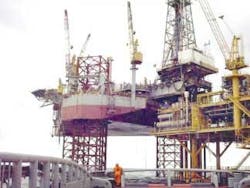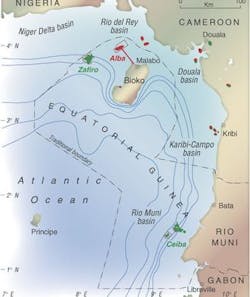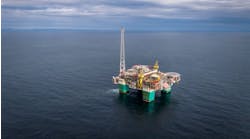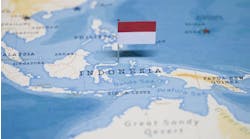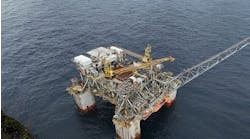Expro takes equipment to new limits
André Minnis
The Expro Group
A new large-diameter slickline installation on the Alba field off Equatorial Guinea proves that continued innovation can save money and time.
In early 2003, Marathon awarded international well performance specialist The Expro Group a contract to provide conveyance services for modular perforating operations with slickline. In executing the project, Expro installed the first operational larger gauge slickline with a diameter of 0.16 in.
Operations began on several platforms in the summer of 2003 in a tropical climate and without the aid of drilling rig support. All of the equipment required full Zone 1 and 2 certification, and work was executed to UK North Sea standards.
The entire operation had to be completed quickly and under pressure because the wells were perforated in underbalanced conditions. Some of the wells were 14,000 ft deep and deviated. The process, in brief, was to run a number of 48-ft, 3 3/8-in. perforating guns on slickline and stack them to lengths that exceeded 1,000 ft in some wells. The firing head was run last on the top and the guns detonated. The same slickline wire retrieved the firing head and guns.
null
null
The challenge
The main difference between the slickline operation carried out on the Alba field and a standard slickline project was the large gun size. The project required pulling wireline weights never previously att-empted so that the number of gun runs could be minimized. Standard 0.125-in. slickline wire with a composition capable of withstanding the 9% CO2 well conditions could not cope with these weights.
At Marathon's request, Expro engineers in Great Yarmouth, UK, determined a new, larger gauge slickline wire would be required. Because of the presence of CO2 in the reservoir, the wire had to be made of a special alloy (GD 31MO) to reduce the risk of corrosion. The increase in wire size created a number of challenges:
- Pulling limits on the stuffing box back bracket increased
- Well containment was required around the larger wire
- Friction between wire and packings became more intense
- Rope socket sizes increased, and there was a need to physically bend the wire to tie a knot
- Special wire bending tools for tying the rope socket were required
- Size and weight of the equipment were greater
- Minimum radius was increased to 20 in.
Because this size of wire had never been made before, it was important to ensure the wire was designed correctly and operated safely to support a number of new innovations and features built into the specification. With an approximate breaking strain of 4,440 lb, the new slickline had a safe working limit of 2,691 lb pulling weight, compared with 1,536 lb for standard wire.
Another key point was the need to perform the entire operation within the safe working life of the guns, so the whole operation of running, firing, and retrieving had to be completed efficiently and effectively. The running speed required to complete this task could not be achieved using braided line, which was another factor in the choice of slickline for accomplishing the job before the perforating gun charges deteriorated.
The solution
Before contract award, Marathon approved wire procurement, with one of its metallurgists witnessing the manufacturing process at the wire supplier, Central Wire-Erin. Following contract award, Expro designed, manufactured, and tested the additional new equipment.
The first challenge was the way the wire was secured to the tool-string (rope socket). The design used an existing rope socket, but a special new tool had to be made to bend the wire because the sharp radius precluded doing this safely by hand.
The next important area was the well containment or stuffing box. Expro had already been developing a new design suitable to take a wider range of wire diameters. Incorporating all the existing requirements and consumables, the new design also had additional refinements and features to improve cost effectiveness and reduce operating time. The design was finalized, produced, and tested within eight weeks. The result was a universal stuffing box that meets the following criteria:
- Accepts universal slickline wires with diameters of 0.072-0.25 in.
- Extends life of packings
- Reduces rig-up times
- Allows chemical injection with internal chamber
- Heavy duty application
- 0-15,000 psi safe working pressure
- CO2 and H2S service capability
- Changeable quick union to fit any type and size
- Well safe – no components can fall into the well during operations
- Improved blowout preventer.
Other components required re-engineering, including the minimum wire bending radiuses, which had to be increased from 16 in. to 20 in. Marathon wanted to use even larger diameter sheaves, but they could not be used for other operational reasons. The hay pulleys, measure head wheels, and drums also required redesign or modification. The increase in drum size had a knock-on effect on the wireline units, which had to be enlarged to accommodate the drums. The counter head had to be redesigned to accept the larger wire.
An in-line six-cylinder, 120-hp Iveco unit, specially adapted for use in high ambient temperatures, provided increased power to overcome the elevated weights and loads.
To accommodate the length of tool strings and pulling weights, the lubricator had to be in excess of 85 ft, and the platform crane could not be used. A 90-ft mast with a 10-metric-ton column load lifted the lubricator. The mast was required to have a Zone 1 safety rating and to have a compact footprint to fit the limited deck space on the platform. Special operating guidelines and practices were adopted to complete all tasks safely and effectively.
Beginning in June 2003, Expro supplied the required services. The first six months produced encouraging results. The tropical climate created a few problems for the engine and wireline equipment, but the issues were resolved and normal service resumed.
Benefits
According to Marathon, the job saved time and money. "This solution enabled us to complete the job much more quickly than if we used smaller slickline, as well as solving many of the well control issues braided wire might create," Chuck Rindels, completion engineer at Marathon, said. "We ran the guns faster, used less equipment, and it was more cost effective too."
Using the new slickline design resulted in an estimated 25% savings in running costs compared to the cost of the alternative braided wire method. "We are tracking the total running feet and number of bend cycles the 0.16-in. wire has endured. On a single spool of wire, these numbers are already in the millions of feet run and hundreds of bend cycles. It has certainly exceeded our expectations," Phil Snider, senior technical consultant with Marathon said. Marathon also expressed a willingness to share the tracking information with other operators.
The use of the new 0.16-in. wire on the Alba field has sparked interest in the technology from other operators that see potential for application in different global locations. Meanwhile, work is not at a standstill. Expro is also working on further expanding the capabilities of slickline.
Another first
The Expro Group carried out its first tubing conveyed sampling operations last November on Woodside Petroleum Mauritania's Chinguetti 4-5 (A-EDW) appraisal/early development well off West Africa. Expro also performed a production test on the well from onboard GlobalSantaFe's Jack Ryan drillship operating in 2,690 ft of water.
A primary objective of most well tests is the collection of representative downhole fluid samples. The Expro tubing conveyed sampling (TCS) system provides an alternative to traditional drill stem test type full-flow samplers. The TCS system is the first to collect up to six samples on a single carrier. Woodside selected the TCS system for its deepwater well to avoid running wireline from a dynamically positioned (DP) vessel.
Traditional techniques allow only two samples to be collected on a single carrier, but the TCS allowed four representative reservoir fluid samples to be obtained simultaneously. The samplers were individually activated using an annulus pressure signature method, where the tool is programmed to operate when certain pre-established criteria are met. The system complements other annulus operations rather than restricting them with rupture disc activation.
Expro TCS logic employed time, pressure, and temperature safety interlocks to prevent the samplers' being mistakenly activated. The results were an estimated 10% savings in rig time, as well as a reduction in the level of risk associated with alternative wireline activities.
This deployment of the TCS shows it as an attractive option for acquiring quality pressure/volume/temperature downhole samples in environments where wireline sampling is undesirable or even impossible, such as from DP vessels or in highly deviated wells. The TCS is also suitable for wells that produce unconsolidated sands.
Author
André Minnis is technical manager for cased hole services for Expro's Africa/Asia region. Based in Great Yarmouth, UK, Minnis has 20 years' oilfield experience with Expro. Contact the author at [email protected] or +44 1493 600021.

